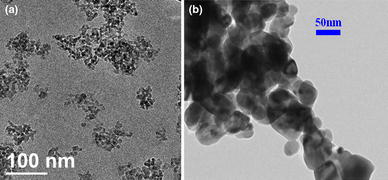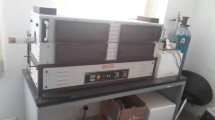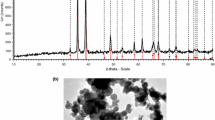Abstract
Single Cu nanorods and decorated Cu nanorods with Ag nanoparticles (Cu-Ag nanorods) are synthesized by hydrothermal procedure for investigation the thermal conductivity of water-based nanofluids. The characterization of the synthesized samples is carried out using XRD and TEM. The XRD results show that the observed characteristic peaks belong to crystalline structure of Cu and Ag. The results of TEM reveal that spherical Ag nanoparticles with attach on the surface of Cu with rod morphology. The thermal conductivity variation of the prepared nanofluids is studied by changing the temperature (ranging from 25°C to 55°C) and weight fraction (ranging from 0.25%wt to 1%wt). The results show that the thermal conductivity enhances by increasing the both of temperature and weight fraction. The collation between the thermal conductivity of Cu nanofluids and Cu-Ag nanofluids verifies that the thermal conductivity of Cu-Ag nanofluids is higher than that of Cu nanofluids. Theoretical models compare the measured values of the thermal conductivity in the both nanofluids. The results show that in both of studied nanofluids, the measured magnitude of thermal conductivity is more than that of estimated amount by theoretical equations.







Similar content being viewed by others
References
Wu G, Yang J, Ge SH, Wang Y, Chen M, Chen Y Thermal conductivity measurement for carbon-nanotube suspensions with the 3ω method
Amani P, Vajravelub K (2018) Intelligent modeling of rheological and thermophysical properties of green covalently functionalized graphene nanofluids containing nanoplatelets. Int J Heat Mass Transf 120:95–105
Amani M, Amani P, Kasaeian A, Mahian O, Pop I, Wongwises S (2017) Modeling and optimization of thermal conductivity and viscosity of MnFe2O4 nanofluid under magnetic field using an ANN. Sci Rep 7:1–13
Amani M, Amani P, Kasaeian A, Mahian O, Wongwises S (2017) Thermal conductivity measurement of spinel-type ferrite MnFe2O4 nanofluids in the presence of a uniform magnetic field. J Mol Liq 230:121–128
Amani M, Amani P, Mahian O, Estellé P (2017) Multi-objective optimization of thermophysical properties of eco-friendly organic nanofluids. J Clean Prod 166:350–359
Patel HE, Anoop KB, Sundararajan T, Das SK (2008) Model for thermal conductivity of CNT-nanofluids. Bull Mater Sci 31:387–390
Abbasi S, Zebarjad SM, Baghban SHN, Youssefi A, Ekrami-Kakhki M-S (2015) Experimental investigation of the rheological behavior and viscosity of decorated multi-walled carbon nanotubes with TiO2 nanoparticles/water nanofluids. J Therm Anal Calorim
Manjula S, Kumar SM, Raichur A, Madhu GM, Suresh R, Raj MALA (2005) Sedimentation study to optimize the dispersion of alumina nanoparticles in water. Cerâmica 51:121–127
Abbasi S, Zebarjad SM, Baghban SHN, Youssefid A (2016) Comparison between experimental and theoretical thermal conductivity of nanofluids containing MWCNTs decorated with TiO2 nanoparticles. Exp Heat Trans 29:781–795
Abbasi S, Zebarjad SM, Baghban SHN, Youssefi A (2014) Statistical analysis of thermal conductivity of nanofluid containing decorated multi-walled carbon nanotubes with TiO2 nanoparticles. Bull Mater Sci 37:1439–1445
Nourivatan F, Abbasi S (2017) Investigation of thermal conductivity of Nanofluids containing decorated ag Nanorods with cu nanoparticles using statistical method. J Adv Mater Proc 5:87–98
Goharshadi EK, Ahmadzadeh H, Samiee S, Hadadian M (2013) Nanofluids for heat transfer enhancement-a review. Phys Chem Res 1:1–33
Eastman JA, Choi SUS, Li S, Thompson LJ, Lee S (1997) Enhanced thermal conductivity through the development of nanofluids, Komarneni, S., Parker, J.C., Wollenberger, H.J. (Eds.), Nanophase and Nanocomposite Materials II. MRS, Pittsburg, PA, pp. 3–11
Xuan Y, Li Q (2000) Heat transfer enhancement of nanofuids. Int J Heat Fluid Flow 21:58–64
Eastman JA, Choi SUS, Yu W, Thompson LJ (2001) Anomalously increased effective thermal conductivity of ethylene glycol-based nanofluids containing copper nanoparticles. Appl Phys Lett 78:718–720
Jana S, Salehi-Khojin A, Zhong WH (2007) Enhancement of fluid thermal conductivity by the addition of single and hybrid nano-additives. Thermochim Acta 462:45–55
Liu MS, Lin MCC, Tsai CY, Wang CC (2006) Enhancement of thermal conductivity with cu for nanofluids using chemical reduction method. Int J Heat Mass Transf 49:3028–3033
Lee D, Kim JW, Kim BG (2006) A new parameter to control heat transport in Nanofluids: surface charge state of the particle in suspension. J Phys Chem B 110:4323–4328
Godson L, Raja B, Lal DM, Wongwises S (2010) Experimental investigation on the thermal conductivity and viscosity of SILVER-deionized water NANOFLUID. Exp Heat Trans 23:317–332
X. Fang, Q. Ding, L.-W. Fan, Z.-T. Yu, X. Xu, G.-H. Cheng, Y.-C. Hu, and K.-F. Cen, "Thermal conductivity enhancement of ethylene glycol-based suspensions in the presence of silver nanoparticles of various shapes," J Heat Transf, vol. 136, pp. 034501–034507, 2014
Ghosh MM, Ghosh S, Pabi SK (2012) On synthesis of a highly effective and stable silver Nanofluid inspired by its multiscale modeling. Nanosci Nanotechnol Lett 4:1–6
Wang X-Q, Mujumdar AS (2008) A review on nanofluids-part l: theoretical and numerical investigations. Bra J Chem Eng 25:613–630
Kakaç S, Pramuanjaroenkij A (2009) Review of convective heat transfer enhancement with nanofluids. Int J Heat Mass Transf 52:3187–3196
Hamilton RL, Crosser OK (1962) Thermal conductivity of heterogeneous two-component system. Indust Eng Chem Fund 1:187–191
Xue QZ (2005) Model for thermal conductivity of carbon nanotube-based composites. Physica B 368:302–307
Liu Z, Yang Y, Liang J, Hu Z, Li S, Peng S, Qian Y (2003) Synthesis of copper nanowires via a complex-surfactant-assisted hydrothermal reduction process. J Phys Chem B 107:12658–12661
Das SK, Putra N, Thiesen P, Roetzel W (2003) Temperature dependence of thermal conductivity enhancement for nanofluids. J Heat Transf 125:567–574
Abbasi S, Zebarjad SM, NoieBaghban SH, Youssefi A, Ekrami-Kakhki MS (2015) Thermal conductivity of water based Nanofluids containing decorated multi walled carbon nanotubes with different amount of TiO2 nanoparticles. Iran J Chem Eng 12:30–40
Murshed SMS, Leong KC, Yang C (2008) Thermophysical and electrokinetic properties of nanofluids–a critical review. Appl Therm Eng 28:2109–2125
Kumar DH, Patel HE, Kumar VRR, Sundararajan T, Pradeep T, Das SK (2004) Model for heat conduction in Nanofluids. Phys Rev Lett 93:144301–144304
Acknowledgements
The author thanks the head of Central Research Nano Laboratory of Esfarayen University of Technology.
Author information
Authors and Affiliations
Corresponding author
Ethics declarations
Conflicts of interest
The authors declare no conflict of interest.
Additional information
Publisher’s Note
Springer Nature remains neutral with regard to jurisdictional claims in published maps and institutional affiliations.
Rights and permissions
About this article
Cite this article
Abbasi, S. The thermal conductivity modeling of nanofluids involving modified Cu nanorods by Ag nanoparticles. Heat Mass Transfer 55, 891–897 (2019). https://doi.org/10.1007/s00231-018-2476-2
Received:
Accepted:
Published:
Issue Date:
DOI: https://doi.org/10.1007/s00231-018-2476-2




